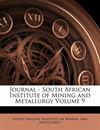热处理木炭的电阻率
IF 0.9
4区 材料科学
Q4 METALLURGY & METALLURGICAL ENGINEERING
Journal of the Southern African Institute of Mining and Metallurgy
Pub Date : 2023-11-15
DOI:10.17159/2411-9717/2477/2023
引用次数: 0
摘要
这项研究旨在确定高温热处理对木炭电阻率的影响。两种不同类型的木材(桉树和黑荆树)样品在 700°C 的甑中进行热解,得到的木炭在感应炉中进行热处理,温度从 800°C 到 1800°C,停留时间从 60 分钟到 120 分钟不等。冷却后,使用四点探针技术测量样品在室温下的电阻率。结果发现,随着热处理温度的升高,木炭的电阻率降低,在较高温度下接近渐近值。停留时间越长,电阻率越小,但这种影响并不明显。本文章由计算机程序翻译,如有差异,请以英文原文为准。
Electrical resistivity of heat-treated charcoal
The aim of this investigation was to determine the effect of high-temperature heat treatment on the electrical resistivity of charcoal. Samples of two different wood types (eucalyptus and black wattle) were pyrolised in a retort at a temperature of 700°C and the resulting charcoals heat-treated in an induction furnace at temperatures from 800°C to 1800°C and residence times from 60 to 120 minutes. After cooling, the resistivities of the samples were measured at room temperature using the four-point probe technique. It was found that as the heat treatment temperature increased the electrical resistivity of the charcoal decreased, approaching an asymptotic value at higher temperatures. Longer residence times decreased the resistivity, but this effect was not pronounced.
求助全文
通过发布文献求助,成功后即可免费获取论文全文。
去求助
来源期刊

Journal of the Southern African Institute of Mining and Metallurgy
METALLURGY & METALLURGICAL ENGINEERING-MINING & MINERAL PROCESSING
CiteScore
1.50
自引率
11.10%
发文量
0
审稿时长
4.3 months
期刊介绍:
The Journal serves as a medium for the publication of high quality scientific papers. This requires that the papers that are submitted for publication are properly and fairly refereed and edited. This process will maintain the high quality of the presentation of the paper and ensure that the technical content is in line with the accepted norms of scientific integrity.
 求助内容:
求助内容: 应助结果提醒方式:
应助结果提醒方式:


